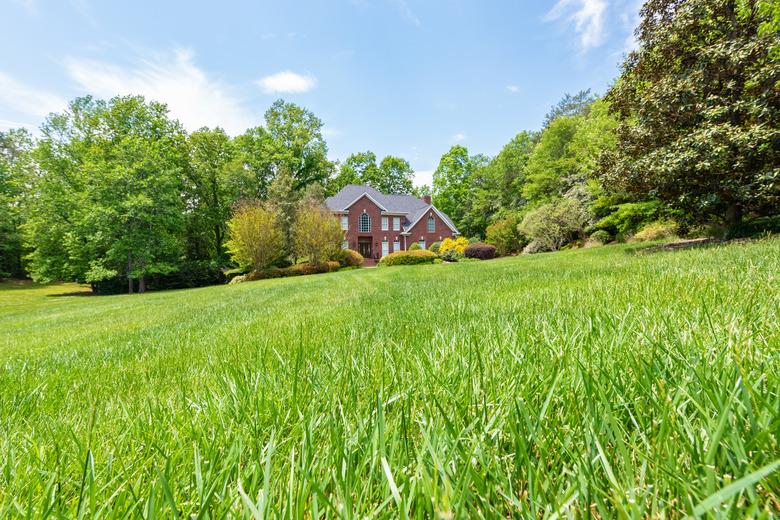What's The Difference Between Kentucky Bluegrass And Fescue?
We may receive a commission on purchases made from links.
Kentucky bluegrass (Poa pratensis) and fescues (Festuca spp.) are cool-season grasses, meaning they grow best in temperatures between 65 and 75 degrees Fahrenheit and are best suited to central and northern parts of the United States. Fescues used for turf include tall fescue (Festuca arundinacea), red fescue (Festuca rubra), and hard fescue (Festuca longifolia). Red fescue and hard fescue are sometimes described as fine fescues because of their fine, needle-like leaves. Comparing the growing patterns and care requirements of the different grass seed varieties helps you choose the best one for your lawn.
Correct Growing Climates
Correct Growing Climates
Kentucky bluegrass grows in U.S. Department of Agriculture plant hardiness zones 1 through 9. Tall fescue grows in USDA zones 3 through 8. Red fescue is hardy in USDA zones 1 through 7, and hard fescue is hardy in USDA zones 4 through 9.
Kentucky Bluegrass vs. Fescue Appearance
Kentucky Bluegrass vs. Fescue Appearance
Despite both being cool-season grasses, Kentucky bluegrass and fescue look different. Kentucky bluegrass has boat-shaped tips, and the leaves are smooth and soft. Tall fescue has flat, smooth, shiny leaves. Hard fescue has very fine blades that look gray to dark green, and the leaves are folded at the bud. Red fescue is also very fine bladed with leaves that fold in the bud and have a deep green color.
Growth and Maintenance
Growth and Maintenance
Kentucky bluegrass seeds are slower to germinate than fescue seeds. Kentucky bluegrass spreads by underground stems called rhizomes, forming a tough, dense sod. When foot traffic or wear causes bare spots, the rhizomes move back in to restore the sod.
Your fescue grass grows in bunches that don't form as dense a sod or spread as well as Kentucky bluegrass rhizomes. You have to reseed bare patches of fescues, while Kentucky bluegrass will spread and repair the patches on its own.
Kentucky bluegrass turf requires more fertilizer and more frequent mowing than fescues. Tall fescue doesn't require mowing less than 3 inches high, and it uses about half as much water as Kentucky bluegrass. Less watering means less mowing. Hard fescue and red fescue require little or no mowing.
Grass Wearing Differences
Grass Wearing Differences
Rich, thick Kentucky bluegrass tolerates foot traffic and heavy use better than either hard or red fescue. However, coarse-bladed tall fescue is more tolerant of foot traffic than Kentucky bluegrass and can withstand the wear of people getting in and out of vehicles. Grayish to dark green, fine-bladed hard fescue fares best in parks, media strips, and slopes that aren't mowed. It's easily damaged by heavy traffic and doesn't recover well from overuse. Red fescue, another fine fescue, doesn't like heavy use.
Ideal Growing Environment
Ideal Growing Environment
While Kentucky bluegrass prefers full sun, it will tolerate shade. It can live through cold winters, but it's susceptible to weed invasion and diseases in climates with hot summers. It may go dormant and turn brown.
Tall fescue will tolerate both drought and summer heat and resists disease and weeds. Hard fescue also tolerates drought and summer heat and is the grass of choice for shade. Red fescue tolerates drought and shade better than Kentucky bluegrass. It establishes quickly and is often planted around cabins, resorts, and camps in cool mountain sites. Hard fescue tolerates drought, cold temperatures, and shade.
References
- University of California Integrated Pest Management: Turf Adaptations and Tolerances – Not Adapted to Hot Climates
- University of California Integrated Pest Management: Kentucky Bluegrass – Poa Pratensis
- University of California Integrated Pest Management: Tall Fescue Tall fescue – Festuca Arundinacea
- University of California Integrated Pest Management: Red Fescue – Festuca Rubra
- University of California Integrated Pest Management: Hard Fescue – Festuca Longifolia
